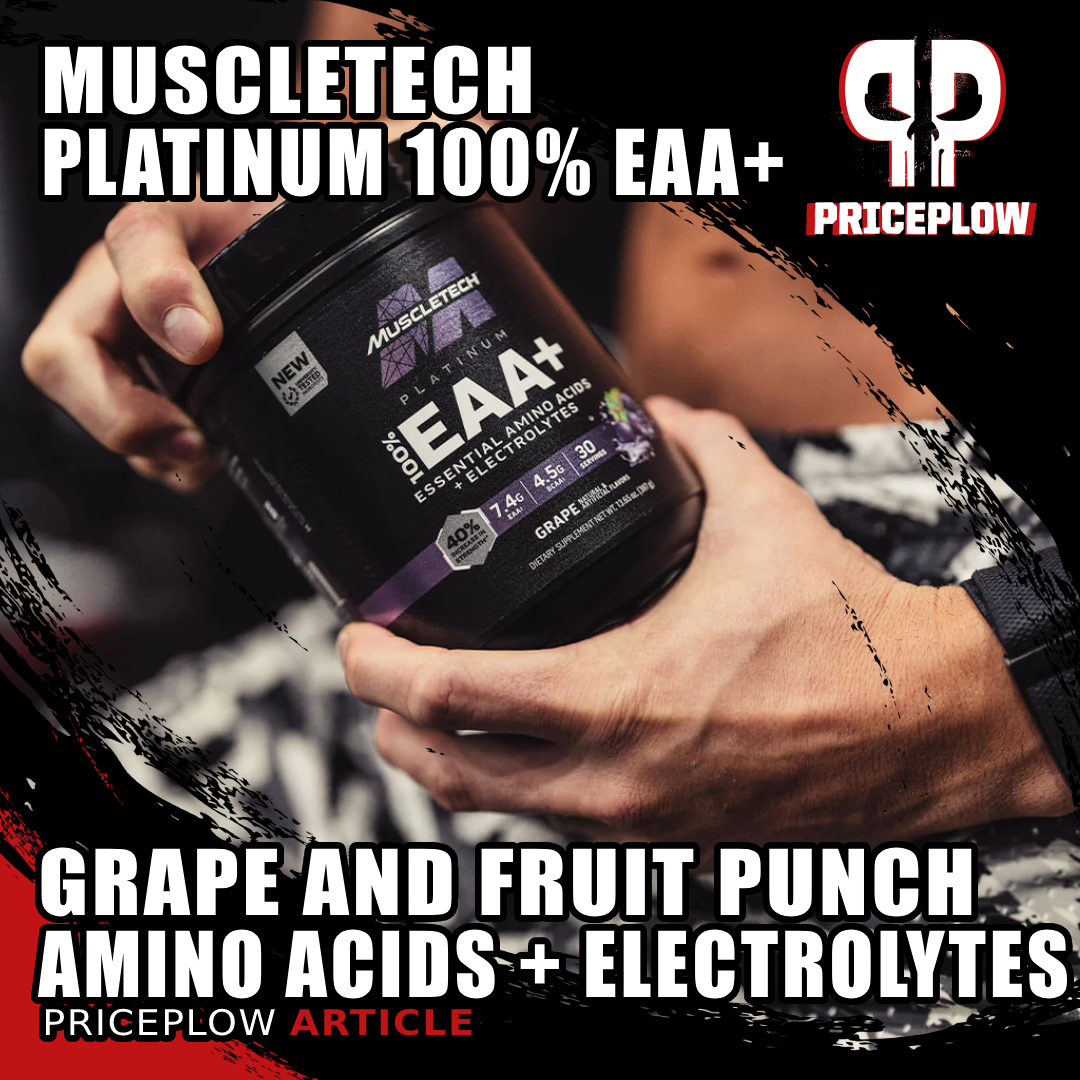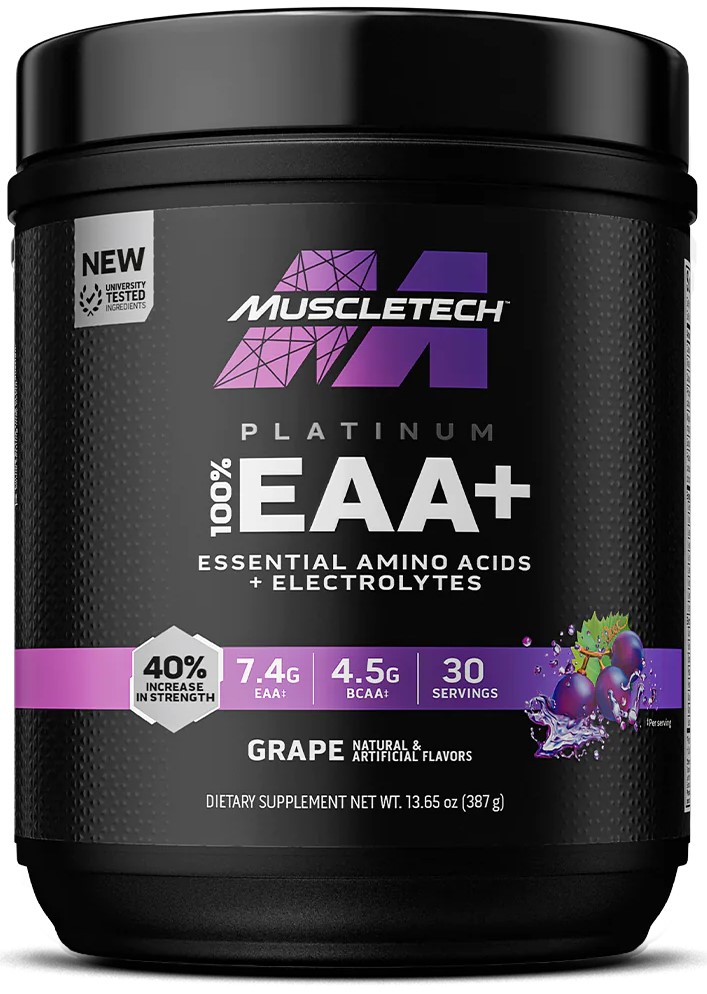For many years, BCAAs were the gold standard for amino acid supplementation. More recently, EAAs have taken over the mantle. Amino acids are vital components for an incredible number of bodily functions, and supplemental essential amino acids have a huge quantity of research to back up their efficacy.
MuscleTech – the brand that has brought us some true innovation in the form of paraxanthine in their EuphoriQ and Burn iQ.
MuscleTech: Platinum 100% EAA+
MuscleTech's contribution to the EAA market is Platinum 100% EAA+, a formula engineered to maximize performance benefits as well as hydration. No need for a separate hydration product!
We're going to dive into how MuscleTech Platinum 100% EAA+ works, but first, let's check the PricePlow for good MuscleTech deals, and check out our video review of the product:
MuscleTech Platinum 100% EAA+ – Deals and Price Drop Alerts
Get Price Alerts
No spam, no scams.
Disclosure: PricePlow relies on pricing from stores with which we have a business relationship. We work hard to keep pricing current, but you may find a better offer.
Posts are sponsored in part by the retailers and/or brands listed on this page.
This area is reserved for Team PricePlow's upcoming videos.
Subscribe to our channel and sign up for notifications so you catch it when it goes live!
MuscleTech Platinum 100% EAA+ – How It Works
Each 13g scoop of Platinum 100% EAA+ contains the following ingredients:
Essential Amino Acid Complex
- L-leucine (3g) primarily stimulates the mechanistic target of rapamycin (mTOR) pathway,[1] which is essential for muscle protein synthesis and growth, making it the most highly dosed amino acid in this and many other formulas.
- L-threonine (1.67g) plays a crucial role in digestive health[2] by aiding in the formation of glycine and serine, supporting intestinal wall functions and mucus lining maintenance,[3] and excelling in collagen synthesis and fatty acid oxidation.[4]
- L-isoleucine (750mg) not only plays a key role in muscle protein synthesis but also aids in recovery by enhancing glucose uptake post-training.[5]
- L-valine (750mg) aids in glycogen synthesis,[6] is crucial for endurance and post-workout recovery, but also produces the metabolite L-BAIBA, which signals exercise activity in the body, leading to numerous exercise-related benefits.[7]
- L-lysine (500mg) is essential for cell growth, muscle protein synthesis, immune system enhancement, and inflammation reduction,[8] assists in breaking down fatty acids with carnitine,[8] and is uniquely ketogenic,[9] unlike most amino acids, making it ideal for ketone production alongside leucine.
- L-phenylalanine (334mg) combines the diverse functions of amino acids with nootropic-like traits, enhancing the production of neurotransmitters like dopamine, epinephrine, and norepinephrine,[10,11] which are linked to happiness and relaxation.
- L-histidine (250mg) not only converts to histamine for allergy protection but is also essential for maintaining hemoglobin levels[12] for oxygen transport and contributes to the production of carnosine,[13] an antioxidant beneficial for brain health.
- L-methionine (150mg) is integral to the digestive system, transforms into cysteine vital for immune health,[14] and assists in producing glutathione to counteract oxidative stress.
- L-tryptophan (80mg) acts as a precursor to serotonin, which controls sleep, mood, and mental cognition,[15] and is under research for its potential in treating psychiatric disorders.
MuscleLyte Hydration Blend
- Calcium potassium phosphate citrate (250mg) is a blend of the essential minerals calcium, phosphorus, and potassium, which are all vital for maintaining proper hydration.
- The sodium in MuscleTech's formula comes from sodium citrate (250mg), sodium chloride (50mg), and himalayan pink sea salt (50mg). Sodium is critical for numerous biological functions, and is particularly necessary for athletes who lose a lot of salt through sweat.[16] With the majority of the sodium in Platinum 100% EAA+ coming from sodium citrate, there is a lower amount of chloride, which some may prefer.
- For some additional potassium, MuscleTech has included dipotassium phosphate (151mg) and potassium bicarbonate (140mg). Maintaining a proper sodium / potassium ratio is crucial for ensuring proper cardiovascular support and improved blood flow.[17-22]
- As for magnesium, MuscleTech has included magnesium bisglycinate chelate (50mg) and magnesium oxide (50mg). Magnesium plays a role in over 600 biological actions ranging from protein synthesis to energy production.[23] For optimal health, adequate magnesium is a must.
All MuscleTech Platinum 100% EAA+ flavors
Check out our up-to-date list of flavors below:
Full-body replenishment
Whether you're going for muscle protein synthesis or energy levels, EAAs have a wide-ranging beneficial impact. Following a tough workout, your body needs all of the building blocks to effectively repair itself.
It doesn't stop at amino acids, though. With the MuscleLyte Hydration Blend, you can likewise replenish all of the essential minerals – such as sodium, potassium, calcium, and phosphorus – to maintain proper hydration.
MuscleTech Platinum 100% EAA+ – Deals and Price Drop Alerts
Get Price Alerts
No spam, no scams.
Disclosure: PricePlow relies on pricing from stores with which we have a business relationship. We work hard to keep pricing current, but you may find a better offer.
Posts are sponsored in part by the retailers and/or brands listed on this page.





Comments and Discussion (Powered by the PricePlow Forum)